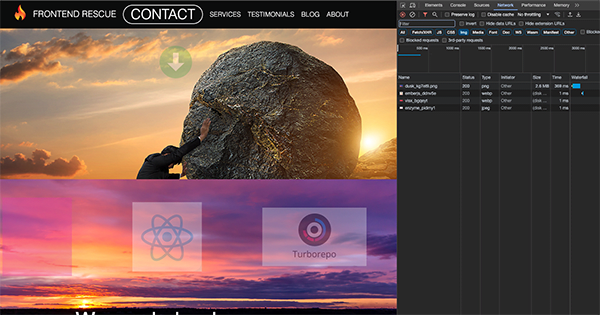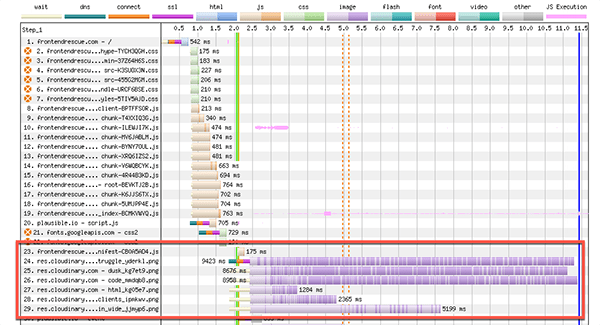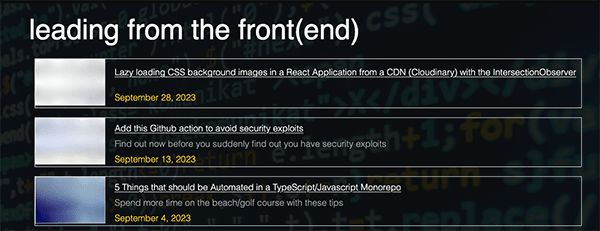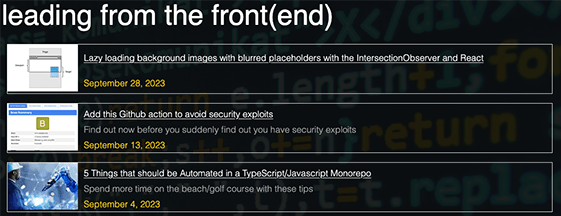Lazy loading background images with the IntersectionObserver and React with low-quality image placeholders created with blurhash

Know your performance metrics on every commit
In a recent post titled 5 Things that should be Automated in a TypeScript/Javascript Monorepo, I mentioned the importance of automating performance metrics.
I have a GitHub action that adds performance metrics as a comment to a pull request on every commit. I use webpagetest to run the tests, and the results highlight the unnecessary loading of all the large images on the website you are currently viewing's home page.

The home page is comprised of five large background images, each filling the whole viewport as the user scrolls down. Loading all these images up front is a wasteful performance hit. A better idea is to lazy load the images as the user scrolls down the page.
Why not use the img tag's loading attribute?
The loading attribute on an <img> element can instruct the browser to defer the loading of off-screen images until the user scrolls near them.
<img src="image.jpg" alt="lazy loaded" loading="lazy" />
Unfortunately, the large images in question are set using the background-image CSS property:
background-image: url(https://res.cloudinary.com/666/image/upload/v66/struggle_yderkl.png);
Low Quality Image Placeholders (LQIP)
Lazy loading is one part of the challenge, and another is to prevent the user from staring at a blank space until the image has loaded. It is currently good practice to provide a low-quality blurred image that bares a representation of the actual image, as you can see on my blog listing below:

A low-quality placeholder resembling the original image fills the space until the actual images are loaded and ready to view. The placeholder has significantly less download size in kilobytes.
Once the image has loaded, the placeholder is replaced with the actual image.
The blurhash package can help us create a low-quality image placeholder from an image.
blurhash
blurhash generates compact representations of a placeholder for an image. Developing blurhashes is an expensive operation and not the sort you want to do at runtime. All the images on this website are stored in cloudinary, so I created this npm package that will iterate all the images of a Cloudinary account and create a JSON file with the image properties and the burhash that looks like this:
[
{
"id": "blurhash_vnbpuj.png",
"url": "https://res.cloudinary.com/acc/image/upload/v666/blurhash.png",
"blurhash": "UG8}0+_N-;xvxaocWAaxIVIVIUM{WBfRWAWB",
"width": 600,
"height": 231
},
...
]
The JSON file negates the need to create the blurhash at runtime.
BlurHash takes an image and gives you a short string (only 20-30 characters!) that represents the placeholder for this image. The string is highlighted on line 5 of the JSON in the above sample, which my npm package package generated.
For HTML img elements, I use the LazyLoadedImage component that is listed below:
import { blurhashToGradientCssObject } from "@unpic/placeholder";
import { Image, type ImageProps } from "@unpic/react";
import { useMemo } from "react";
import { getImagePropsFromMap } from "./getImagePropsFromMap";
type Layout = ImageProps["layout"];
type LazyLoadedImageProps = Omit<ImageProps, "layout"> & {
layout?: Layout;
} & React.RefAttributes<HTMLImageElement>;
export function LazyLoadedImage({
src,
width,
height,
loading = "lazy",
layout = "constrained",
...props
}: LazyLoadedImageProps): JSX.Element {
const image = getImagePropsFromMap(src);
const { blurhash, ...imageProps } = image;
const placeholderStyle = useMemo(
() => blurhashToGradientCssObject(blurhash),
[blurhash]
);
return (
<Image
loading={loading}
layout={layout as any}
width={width ?? imageProps.width}
height={height ?? imageProps.height}
style={placeholderStyle}
src={src}
{...props}
/>
);
}
I use @unpic/placeholder to transform the blurhash into a style object that I pass as a prop to the @unpic/react Image component that I use for responsive images.
I get the blurhash from the JSON file I generated with my package on line 18 of the above code sample.
The blurhashToGradientCssObject function will return the style object from the blurhash on line 22.
The rendered img tag and style attribute will look something like this:
<img loading="lazy" style="object-fit:cover;max-width:600px;max-height:400px;aspect-ratio:1.5;width:100%;background-image:radial-gradient(at 0 0,#ffffff,#00000000 50%),radial-gradient(at 33% 0,#fefefc,#00000000 50%),radial-gradient(at 67% 0,#edecee,#00000000 50%),radial-gradient(at 100% 0,#f4f4f6,#00000000 50%),radial-gradient(at 0 50%,#fdfffe,#00000000 50%),radial-gradient(at 33% 50%,#f9f8f7,#00000000 50%),radial-gradient(at 67% 50%,#e5e6e9,#00000000 50%),radial-gradient(at 100% 50%,#edeef1,#00000000 50%),radial-gradient(at 0 100%,#fbffff,#00000000 50%),radial-gradient(at 33% 100%,#fafbfa,#00000000 50%),radial-gradient(at 67% 100%,#e0e5eb,#00000000 50%),radial-gradient(at 100% 100%,#e4eaf1,#00000000 50%)" decoding="async" sizes="(min-width: 600px) 600px, 100vw" srcset="<rest>">
That takes care of the best practices for low-quality blurred image placeholders.
Can we please get to the IntersectionObserver!!
When the image is set with the background-image CSS property, lazy loading the image is a little trickier, and this is when the IntersectionObserver finally makes an appearance.
The IntersectionObserver API is relatively new in browsers. It makes it simple to detect when an element enters the viewport, and you can execute a callback when it does.
I use the following LazyBackgroundImage component:
interface LazyBackgroundImageProps {
backgroundImage: string;
}
export function LazyBackgroundImage({
backgroundImage,
}: LazyBackgroundImageProps): JSX.Element {
const containerRef = useRef<HTMLDivElement>(null);
const [visible, setVisible] = useState(false);
const callback = useCallback((entries: IntersectionObserverEntry[]) => {
const [entry] = entries;
if (entry.isIntersecting) {
setVisible(true);
}
}, []);
useIsomorphicLayoutEffect(() => {
if (!global.IntersectionObserver) {
return;
}
const observer = new IntersectionObserver(callback, {
rootMargin: "0px",
threshold: 0.1,
root: null,
});
if (containerRef.current) {
observer.observe(containerRef.current);
}
return () => {
if (containerRef.current) {
// eslint-disable-next-line react-hooks/exhaustive-deps
observer.unobserve(containerRef.current);
}
};
}, [callback]);
const style = useMemo(() => {
if (!global.IntersectionObserver || visible) {
return { backgroundImage: `url(${backgroundImage})` };
}
const { blurhash } = getImagePropsFromMap(backgroundImage);
return blurhashToGradientCssObject(blurhash);
}, [backgroundImage, visible]);
return <Box ref={containerRef} style={style}></Box>;
}
Lines 10-16 create a callback that is passed as an argument to the IntersectionObserver constructor:
const callback = useCallback((entries: IntersectionObserverEntry[]) => {
const [entry] = entries;
if (entry.isIntersecting) {
setVisible(true);
}
}, []);
The callback is passed an array of IntersectionObserverEntry objects, which are wrappers around any HTML elements that are being observed. The entry has an isIntersecting property that is true when the element is in the viewport. All the callback does is update the visible property of the local state with the setVisible call when isIntersecting is true, which will cause a re-render with the updated value.
Lines 23-27 create the intersection observer:
const observer = new IntersectionObserver(callback, {
rootMargin: "0px",
threshold: 0.1,
root: null,
});
On line 30, the observer is told which element to observe.
observer.observe(containerRef.current);
On lines 42-46, a style object that initially has the blurhash CSS object is created. This object gets swapped for the background image when the observed HTML element is in the viewport.
const style = useMemo(() => {
if (!global.IntersectionObserver || visible) {
return { backgroundImage: `url(${backgroundImage})` };
}
const { blurhash } = getImagePropsFromMap(backgroundImage);
return blurhashToGradientCssObject(blurhash);
}, [backgroundImage, visible]);
return <Box ref={containerRef} style={style}></Box>;
TLDR;
With a combination of the LazyLoadedImage and the LazyBackgroundImage components, we can load the images on demand as the user scrolls down the screen.
Only one large background image is loaded when the home page first loads.
I consider this case closed.
